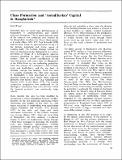| dc.contributor.author | Wood, Geof | en |
| dc.date.accessioned | 2016-04-08T11:10:44Z | |
| dc.date.available | 2016-04-08T11:10:44Z | |
| dc.date.issued | 01/02/1978 | en |
| dc.identifier.citation | Wood, G. (1978) Class Formation and ‘Antediluvian’ Capital in Bangladesh. The IDS Bulletin 9(3): 39-43 | en |
| dc.identifier.issn | 1759-5436 | en |
| dc.identifier.uri | https://opendocs.ids.ac.uk/opendocs/handle/20.500.12413/10866 | |
| dc.description.abstract | SUMMARY Bangladesh has been erroneously attributed a homogeneous agrarian structure by unwarranted extrapolation from surveys made in Comilla district. Data from the 1940s suggests greater differentiation in the North and West. This was compounded by the control of East Bengal by West Pakistan which resulted in a counter?productive drain of the rural surplus, so restricting capital to the ‘antediluvian’ forms used in moneylending, trade or land leasing, rather than capital used in productive agriculture. The development of the petty bourgeoisie and landlords was thereby restricted and the emergence of an East Bengali bourgeoisie prevented. RESUME Formation de classes et capital “antédiluvien” au Bangladesh On a, à tort, établi une structure agraire homogène au Bangladesh en extrapolant sans raison à partir d enquêtes menées dans la région de Comilla. Des données datant des années 40 suggèrent une différenciation plus marquée entre le Nord et l'Ouest. C'était le résultat du contrôle du Bengale oriental par le Pakistan occidental imposant drainage contre?productif des surplus ruraux, limitant ainsi l'utilisation de capitaux aux formes “antédiluviennes” des prêts de fonds, du commerce et des baux à ferme, plutôt que l'investissement dans une agriculture productrice. Le développement de la petite bourgeoisie et de propriétaires fut ainsi limitée et la formation d'une bourgeoisie dans le Bengale oriental entravée. RESUMEN Formación de Clases y Capital “Antidiluviano” en Bangladesh Erróneamente se ha atribuido a Bangladesh una estructura agraria homogénea por una extrapolación incorrecta de los estudios llevados a cabo en el distrito de Comilla. Datos obtenidos en la década de 1940 sugieren una mayor diferenciación en el norte y oeste. Esto fue complicado cuando el control de Bengala del Este pasó a Pakistan Occidental, que resultó en una pérdida contraproductiva de los excedentes rurales, restringiendo asi el capital disponible a las formas “antidiluvianas” de préstamo, comercio o alquiler de terrenos en lugar de capital para usar en la agricultura productiva. De esta forma se limitó la aparición de una pequeña burgesia y pequeños terratenientes, evitando que surgiera una burgesía en Bengala del Este. | en |
| dc.format.extent | 5 | en |
| dc.publisher | Institute of Development Studies | en |
| dc.relation.ispartofseries | The IDS Bulletin Vol. 9 Nos. 3 | en |
| dc.rights.uri | http://www.ids.ac.uk/files/dmfile/IDSOpenDocsStandardTermsOfUse.pdf | en |
| dc.title | Class Formation and ‘Antediluvian’ Capital in Bangladesh | en |
| dc.type | Article | en |
| dc.rights.holder | © 1978 Institue of Development Studies | en |
| dc.identifier.doi | 10.1111/j.1759-5436.1978.mp9003009.x | en |

